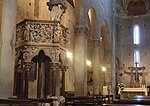Stadio Marcello Melani
Buildings and structures in PistoiaFootball venues in ItalyItalian sports venue stubsSerie A venuesSports venues in Tuscany

Stadio Marcello Melani is the main stadium in Pistoia, Italy. It is currently used mostly for football matches and is the home ground of U.S. Pistoiese 1921. The stadium holds 13,195.
Excerpt from the Wikipedia article Stadio Marcello Melani (License: CC BY-SA 3.0, Authors, Images).Stadio Marcello Melani
Via dello Stadio, Pistoia
Geographical coordinates (GPS) Address Nearby Places Show on map
Geographical coordinates (GPS)
| Latitude | Longitude |
|---|---|
| N 43.940833333333 ° | E 10.914722222222 ° |
Address
Via dello Stadio
51100 Pistoia
Tuscany, Italy
Open on Google Maps











